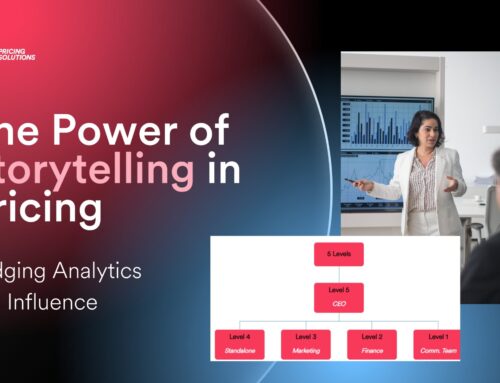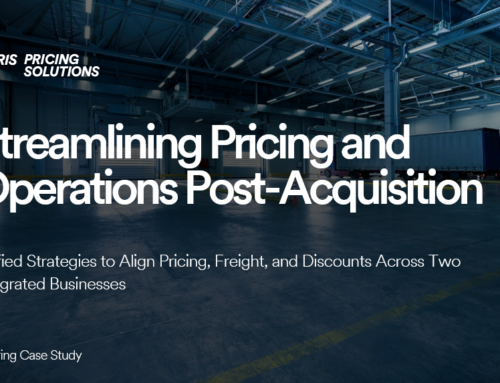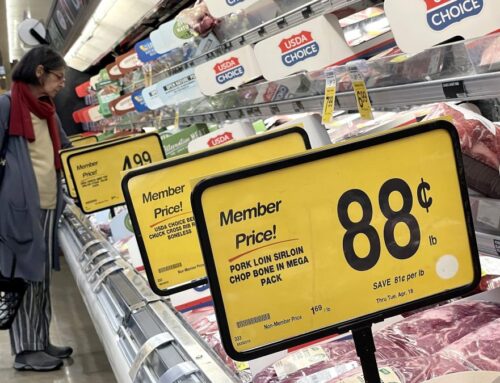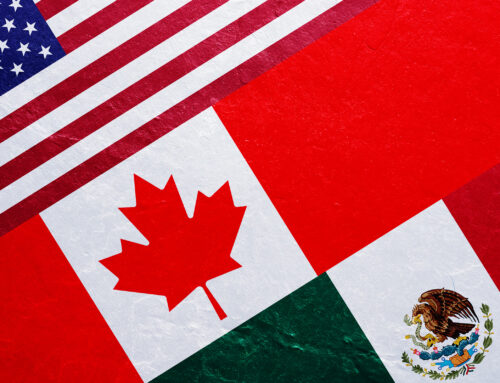Posted by Fred Puech, director of pricing research and analytics at Pricing Solutions.
Pricing is one of the key factors to a successful business model, and it’s also one of the most difficult. Retailers struggle to find the right balance between optimizing profits and maintaining traffic. “It’s probably the toughest thing there is to do,” Charles Toftoy, associate professor of management science at George Washington University tells Inc. “It’s part art and part science.”
Many people see pricing strictly from a financial perspective, but there’s more to a good pricing strategy than that. A sound pricing strategy ensures you’re well positioned to compete, which is why you always need to tie your price to value. While you need to make price part of your offering, your prices must allow you to compete in the market, not with the lowest price, which is easy, but with a good price that makes sense by allowing you to make profit without killing your volume.
Retailers want people in their stores, but most of our clients have gone too far to maintain or grow their traffic – you can only take that so far. We help them create a sustainable pricing strategy that develops healthy margins and good traffic. Here’s how:
1. Price Points
There’s a lot of myths surrounding price points, especially when it comes to having an aversion to rounding up. A surprising number of retailers still apply simple ‘multipliers’ to their cost of goods sold (COGS). They take the cost of an item and multiply it by X to get to their selling price without rounding the resulting price. When this happens it’s very common to see shelves filled with products priced using every dollar increment available, sometimes down to the penny.
Having so many different price points creates confusion in the consumer’s mind. What’s the difference between two similar products that are priced within two-dollars of each other, for example?
The Solution
When looking at the price threshold, it’s critical to leverage what is known about consumer psychology. Studies show that $100 is very different than $99 in the consumer’s mind. There’s also a big difference between prices that are two versus three digits.
We have a client who sells eyewear and frames. They lacked effective price rounding rules and as a result had many different price points that added a lot of complexity and left money on the table. We have seen the application of effective price points reduce complexity and sustainably generate millions of dollars for the bottom line. We typically recommend avoiding having too many price points and leveraging key thresholds strategically.
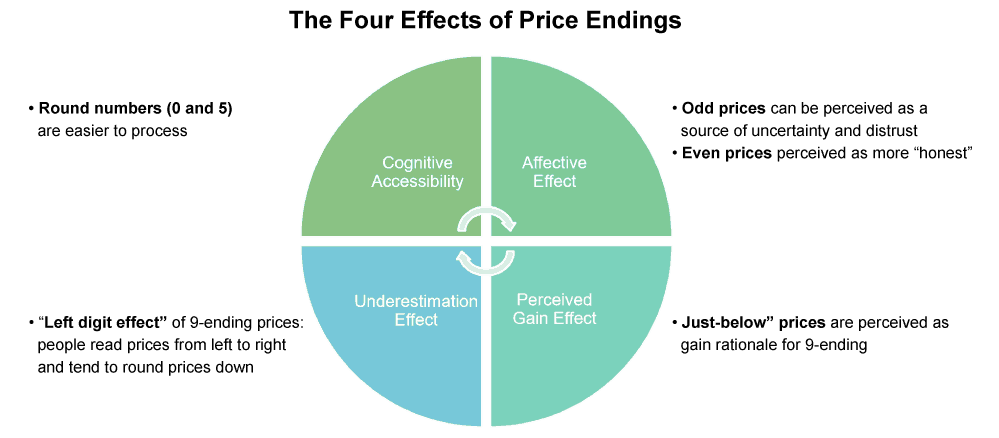
However, setting price points (and price endings) is more complex than it seems. As the chart above shows, price endings have four effects, some of them contradicting the others:
- Round numbers are easier to process and usually perceived as more “honest”
- However, endings in 9 (or .99) can leverage the “left digit effect (people read from left to right and round numbers down) and the “just below” effect ($99 can be perceived as very different from $100)
In addition to it, research has found that the relative strength of these effects depends on the region of the world you are in. In North America, endings in 9 or .99 are the norm, whereas Europe typically uses prices rounded to 0 or 5. In many Asian countries, endings in 8 are very common.
2. Online Competition
When it comes to pricing, how can you compete with online competition, especially giants like Amazon? For many of our clients, the same products as the ones they sell in store can be found online at a significantly lower price. It’s not just an issue for retailers, but for manufacturers too.
The Solution
Trying to compete with Amazon on price is a losing strategy. If you have the same product or SKU sold on Amazon, it is very difficult to compete on price only. Instead, we advise clients to secure an agreement with their manufacturer to get an exclusive product that the manufacturer won’t sell on Amazon.
If you can’t do this, then you need to focus on value. You get what you pay for. If a product you sell is offered on Amazon then you need to offer more value through better service like product demonstrations, the ability to open the box, to try the product on, or to obtain training from staff on how to use the product. Best Buy is a good example of a winning strategy against online competition:
- they invested heavily in training their staff to improve in-store customer service and expanded their offer (they now provide in-home consultations before customers even purchase anything)
- they integrated their stores with their online ordering system: items can now be shipped from the stores themselves (or picked up in store), increasing convenience to the customer
- And to ensure they are price competitive they price match vs. online
The results speak for themselves. In the last 5 years Best Buy’s stock has more than tripled while many other retailers are struggling to stay in business.
3. Discounts and Promotions
When it comes to discounts and promotions, many businesses offer too many, or offer them ineffectively. Many of our clients see discounting as an addiction. They acknowledge it doesn’t work most of the time, but they don’t know how to eliminate it.
Many B2C companies like those in the retail, hotel or restaurant industries become stuck offering too many promotions —senior discounts, new member discounts plus seasonal discounts or price matching— to remain competitive. Heavy discounting may attract traffic in the short-term, but it’s usually not sustainable.
The Solution
Discounting must be done very carefully and strategically. Promotions can be very effective if implemented strategically, especially from a seasonal standpoint. Back to school promotions tend to do well, for example, as do competitor-driven promotions. Other, more ongoing types of discounts have to be tied to a unique value offering, like a bundle, that consumers would be interested in. The retailers leveraging their loyalty programs are typically the most successful at promoting; by using what they know of their customers, they can design targeted offers that typically yields excellent results. For example, a convenience store we worked with noticed that the majority of its loyalty customers were avid coffee drinkers. It then started offering frequency-based discounts (by 10 coffees, get the 11th free) to its loyalty customers and observed an increase in their overall spend and basket size.
On the other hand, combining discounts (e.g. a “new customer” discount on top of a senior discount on top of 50% off) is usually counterproductive and does not drive sales or traffic. As much as possible, the ability to give discretionary discounts must also be taken away from sales staff in store and limited to the store’s management team.
No matter your industry, whether you’re doing a promotion or a discount, it’s important to measure the success of the promotion and base decisions on past performance. In all cases implementing a ‘test-measure-learn’ loop akin to what is done in the software industry is key. Often, we suggest that discounting not be eliminated, but rather optimized.
4. Monitoring Your Progress Towards World Class Pricing
Most retailers are blind when it comes to measuring the performance of their pricing actions, especially when it comes to promotions and discounts, but monitoring is key to the success of all pricing initiatives.
Depending on the size of the business, managing and analyzing the data is a challenge in and of itself. Some businesses are overwhelmed by the sheer size of their data —the Terabyte is the new reference metric nowadays. But more importantly, they struggle with the fact that the data is usually scattered across multiple sources and systems, which can make it hard to reconcile. There is, however, great value in making the initial investment to develop a viable dataset that can be updated and monitored on an ongoing basis.
The Solution
There are great frameworks available, including price-volume-mix variances that can allow a retailer to keep track of its performance and effectively course correct when needed.
It’s usually best to have two years of transactional data, including point of sales data like location, date, time, items bought, quantity, net and retail prices. Based on this information, businesses can then consider pricing strategies including segmentation, store tiering, and omni-channel pricing (offering different prices for online vs app vs in-store transactions). For chains and franchises, sometimes store tiering is a potential solution which includes offering different prices for items depending on the location, category or type of merchandise.
Our team usually recommends examining and adjusting pricing as necessary on a monthly or even weekly basis, and to do this effectively, regular price monitoring is absolutely key. Keeping track of how the products’ price elasticity evolves over time is also paramount, even though it usually requires more advanced analytical modeling.
Ultimately, a retail competitive pricing strategy is critical to finding the right balance between a competitive price that will sustain long-term profitability and sales volume. Do you feel your company could benefit from specialist pricing advice? Contact our retail team today to develop a retail pricing management strategy that will help you strike the right balance between traffic and profits.



